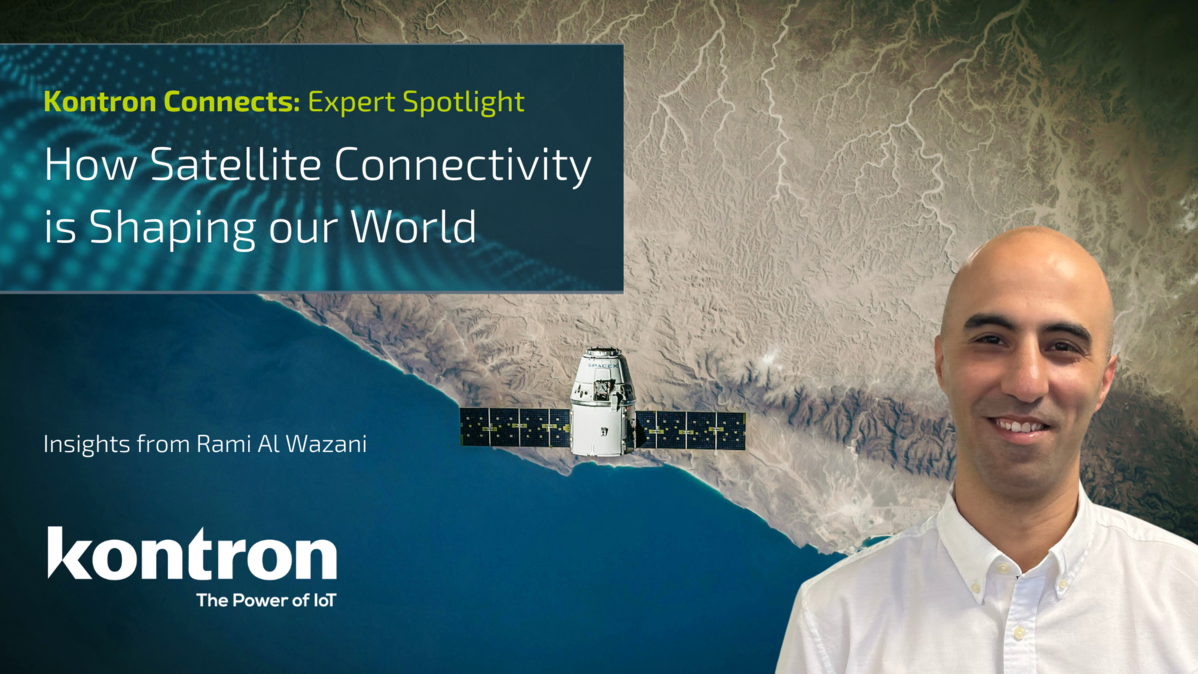Welcome to Kontron Connects, your gateway to unlocking industry insights directly from our experts. Dive into our new series and gain a competitive edge as we provide an in-depth analysis of industry trends and invaluable expertise tailored to your success.
I had the opportunity to interview Rami Al Wazani, our System Engineer specializing in avionics and satellite connectivity. From the technical challenges of seamless in-flight connectivity to the latest advancements in multi-beam satellite operations, his insights shed light on the importance of this technology in providing functions that support a wide range of critical applications and ensure that even the most remote areas remain connected. This interview not only broadens my understanding of satellite connectivity but also emphasizes the critical role it plays in modern aviation and global communication.
Rami, tell us how you got into the fascinating world of satellite connectivity? Where does your passion stem from?
Rami: My journey into this field was inspired by early family influences. Growing up, one of my elderly family members worked with satellites and after seeing my first 36 meter antenna (yes, they were that big at the time), I wanted to learn more about space and how these things work.
Can you describe your role at Kontron and the projects you’re currently working on?
Rami: As a System Design Engineer for our Avionics division, specializing in In-Flight Entertainment and Connectivity systems (IFE&C), I've had the privilege of working on numerous groundbreaking projects, including collaborations with major players in the industry.
Projects gaining traction
Rami: Currently, our line of Cab-n-Connect™ CWAPs (cabin wireless access points) are being used to deploy high speed, highly secure connectivity in the toughest aircraft environments, and are now supporting Wi-Fi 7 technology which is something I helped design. Additionally, our Ace Flight™ KPSU (power supply units) are providing clean, filtered, isolated power to next-gen flat panel Electronically Steered Antennas (ESAs) providing OEMs and system integrators with a cost-effective, flexible solution with the smallest footprint.
Unique designs for the Avionics market
Rami: More and more airlines leverage satellite-based connectivity solutions to provide broader coverage, more capacity, and the ability to cater to more devices, thus more passengers.
Our standard products seamlessly connect to satellites using advanced dual MODMAN configurations. In designing these systems, my team and I meticulously consider all possible use cases, integrating lessons learned from past projects to meet diverse client requirements. Despite the complexities of harmonizing hardware and software, we at Kontron excel in adapting solutions to the stringent demands of our customers.
Recognizing the variability in modem performance, particularly in signal transmission and reception, we ensure our products meet rigorous RF standards. Satellite connectivity remains crucial for airlines to be able to provide better passenger experiences, and I keep this in mind in everything I do.
How does satellite connectivity work in aviation and what impact does it have on passengers?
Rami: It has basically revolutionized global communication, providing vital links where terrestrial networks (land-based in other words) fall short. Satellites relay data between the aircraft and ground stations.
This technology is especially important in aviation, where it enables in-flight connectivity and entertainment systems, ensuring passengers stay connected 30,000 feet in the air. By leveraging satellite networks, airlines can offer things like internet access, streaming services, and real-time communication across vast and remote areas. This comes in handy during long-haul flights, when flying over oceans and secluded regions anywhere in the world.
Are there any advancements coming?
Rami: What’s exciting is that as advancements continue, such as the integration of low Earth orbit (LEO) and geostationary (GEO) satellites, the capabilities of satellite connectivity are expanding, promising higher speeds and more reliable connections. This means that we are getting closer to providing passengers with the same experiences in the air as they are used to receiving in their homes or offices.
What are other use cases or industries whereby satellite connectivity plays a crucial role?
Rami: An example everyone is familiar with is Media and Broadcast. Satellites play a key role in broadcasting television and radio signals globally. They enable live coverage of events, distribution of media content, and transmission of news to a worldwide audience.
Do you have experience in Media and Broadcasting and can you tell us more about it?
Rami: Sure. I remember doing an internship during my college days at Jordan Media City, one of the oldest media cities in the region. During the mini World Cup, I worked as one of the teleport engineers responsible for broadcasting the matches live. When there is a soccer match, people on the ground take video footage and send it to the media city. There, the logos are added, and if there are multiple commentators, their audio is mixed into specific channels. The feed is then sent to the teleport, where it is transmitted via satellite and broadcasted globally.
Satellite broadcasting
Rami: My role involved handling the teleport part, ensuring that the feed was properly received, processed with logos, and then transmitted back for satellite broadcasting. These channels, sent from media cities, are received in households via satellite signals. I worked on this project during the 2009 Confederations Cup in South Africa, which featured Brazil versus USA. This was 13 years before joining Kontron.
What product is Kontron best known for when it comes to satellite connectivity?
Rami: Kontron's Ace Flight™ 4783 Dual Modem Manager (MODMAN) is a powerful system I am proud of, designed to manage and optimize the use of multiple satellite modems within a communication network. It provides a robust solution for ensuring reliable and high-performance satellite connectivity, particularly in demanding environments like Avionics.
What makes the technology unique?
Rami: There are several reasons why we’ve been awarded contracts for this product with huge players in the industry.
Redundancy and reliability
Its setup provides redundancy, ensuring continuous connectivity even if one modem fails. This increases the overall reliability of the communication system, which is crucial for critical applications.
Seamless network transitions
With two modems, the system can switch seamlessly between different satellite networks or frequency bands. This capability ensures uninterrupted service while an aircraft moves between coverage areas of different satellites.
Increased Bandwidth
By utilizing two modems, the system can aggregate bandwidth from multiple satellite links. This results in higher data throughput, supporting more users and enabling streaming and real-time communication.
Enhanced Flexibility
Dual modem capability allows for more flexible network configurations. It can connect to different types of satellites such as LEO, GEO or different service providers, optimizing performance based on location and available networks.
Cost efficiency
By providing the ability to switch between networks, it can help manage costs more effectively. Operators can use the most cost-efficient network available at any given time.
What’s next for Kontron in satellite connectivity?
Rami: Kontron is leading the way in satellite connectivity innovation, also providing ground equipment that supports critical applications like disaster recovery, cellular network expansion, and even military operations. We are actively collaborating on 3GPP standards to ensure seamless connectivity from the moment passengers arrive at the airport until they reach their destination.
My personal journey, inspired by a deep-seated passion for satellite communications, drives my commitment to advancing global connectivity and pushing the boundaries of what is possible in this field.
About Rami

Rami Al Wazani is a highly skilled satellite communications expert with a Bachelor of Science in Electrical Engineering, specializing in Communications and Electronics from Jordan University of Science and Technology. With over 13 years of extensive experience in system integration for military tactical solutions, Rami has demonstrated a profound expertise in designing, managing, and deploying VSAT systems for military applications which he applies to Avionics. His work ensures reliable and secure communication in the most demanding environments.



{{comment.comment}}